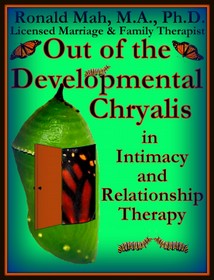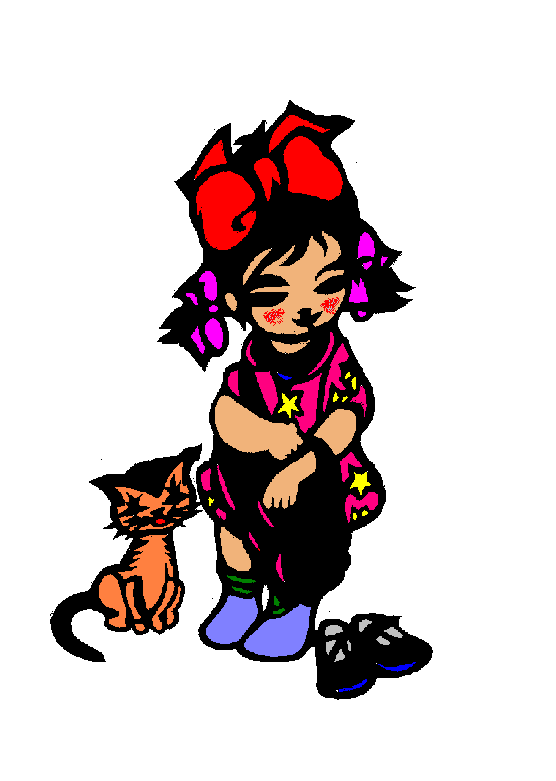13. Practice Anxiety - RonaldMah
Ronald Mah, M.A., Ph.D.

Licensed Marriage & Family Therapist,
Consultant/Trainer/Author
Main menu:
13. Practice Anxiety
Therapist Resources > Therapy Books > Out of Dev Chrysalis Intimacy/Relationship

Out of the Developmental Chrysalis in Intimacy and Relationship Therapy
Chapter 13: PRACTICE ANXIETY
by Ronald Mah

Wright notes that Bowen did not use the term "self-soothing" but instead used "self-regulation" to emphasize that "the ultimate effect or outcome of a differentiation effort may be to feel more comfortable internally, the process of getting there is far from soothing, but rather more anxiety provoking" (page 31). Self-soothing requires paradoxically, movement towards anxiety. The individual must accept and experience more discomfort rather than merely seeking relief or feeling soothed. He or she must practice anxiety in order to not be overwhelmed by it. As the child and individual accepts and develops the skills and strengths to endure uncomfortable emotionally intense situations, he or she learns about his or her capacity to manage and survive uncertain and threatening experiences especially with intimate others. A sense of competence and resiliency develops with an increased ability to be objective and flexible assessing others, the situation, and options to problem-solve. Instead of defaulting to shutting down, running away, attacking, disassociating, flipping out with rage or despair, or other problematic reactions, the individual can consider a healthier set of possible choices when confronted with tense interactions in the relationship dynamics. "Thus, the path to a greater capacity for self-soothing depends on having the courage to engage in emotionally intense situations repeatedly and to tolerate the anxiety and internal emotional reactivity associated with that engagement (Kerr & Bowen, 1988)" (Wright, 2009, page 32). Learning to self-soothe, to have courage, to tolerate emotionally intense situations, to tolerate anxiety and internal emotional reactivity, and to stay engaged takes practice. And that practice starts in early infancy, goes through childhood in the context of the family and culminates with the partner in the couple. By the time Vlad was old enough to engage in intimate relationships, rather than practice anxiety and self-soothing, he tried as hard as possible to avoid anxiety. Soliciting frequent reassurance and attention from Collyn was how he sought to avoid his perpetual anxiety.
Wright says that in Bowen theory, "anxiety can be defined as the arousal of the organism upon experiencing a real or imagined threat. When so aroused the emotional system of the anxious individual tends to override the cognitive system and behaviour becomes increasingly automatic" (page 33). In the aroused state, the baby can only cry his or her distress. With maturation, the individual may makes choices primarily from subjective internal feelings that may or may not be counterbalanced by a rational cognitive process that reviews objective facts for considering response options. In highly charged emotional situations according to Bowen, people have varying ability to access rational thinking according to differences in a continuum in their degree of differentiation of self. Anxiety can become pervasive if the individual frequently or consistently continues in distress. "The higher the level of chronic anxiety within an individual or relationship system, that is, the greater the sensitivity to relational forces, the less adaptive individuals are to episodes of acute anxiety. Chronic anxiety can result in a sustained and generalized state of arousal within the individual and involves responses in both the autonomic and central nervous systems. Once triggered, chronic anxiety sets off a cascade of instinctual responses, actions and reactions that quickly gather momentum and become largely independent of the triggering stimuli. Chronic anxiety is subtle and pervasive and runs like a silent undercurrent guiding all human relationships (Ferrera 1999). The physical manifestations of anxiety are possibly the most well-known and can range from tightened muscles, shallow breathing, increased heart rate, and changes in skin temperature to churning nausea, dizziness, suffocation and gripping pain" (Wright, 2009, page 32-33).
Chronic anxiety influences the way individuals think and how they interrupt their experiences with others such as their partners. The anxiety can unconsciously influence how individuals develop a belief system, organize behavior, alter personality, and drive or divert feelings. Anxiety is related to but has distinctive qualities that separate it from fear. In some ways, fear and dealing with fear (even phobia) is relatively simple. Fear is specific. A fear is centered on one thing or one experience or situation. A person may have a fear of snakes or a fear of heights. Experience is the healing or change principle. Avoiding the experience-- avoid snakes or avoid heights. No snakes or never go up high "solves" the fear by avoiding the fear-inducing experience or situation. Or, new experiences with the feared object (snake) or circumstance (heights) with benign or positive consequences can reduce and eventually extinguish or functionally make the previously fearful experience tolerable. Coupled with supportive people, guided imagery, and relaxation exercises such as deep breathing, fears can be addressed with intuitive or professionally guided systematic desensitization (Encyclopedia of Mental Disorders, www.minddisorders.com, 2010). Systematic desensitization is a behavior modification technique that works by substituting a new response to a feared situation that is irreconcilable with progressive relaxation and other positive experiences. In contrast to fear, however anxiety is non-specific, not always identifiable, unpredictable, and un-anticipatable fear of something… that something bad may happen or arise. "What, I don't know… when, I can't predict, how badly, I can't tell… why, I have no idea!" It could be something experienced before, something entirely new, or a new version of something from before. Prior devastating, to benign, to positive outcomes or responses predict nothing to how poorly or well "it" will be handled next time… if and when it will happen! Anxiety is that something bad will happen eventually.
While normal anxiety usually can serve individuals, chronic anxiety is much more difficult to deal with. Individuals develop hyper-vigilance and hypersensitivity to avoid being ambushed, because of an almost certainty that they will be caught unawares… again. Vlad's anxiety was extreme and unjustified based on the relationship history with Collyn. Despite relative consistency and attention from Collyn, Vlad could not trust that he would not be betrayed again because of his relationship history with his parents. For infants and individuals with insecure attachment or stuck in relationships with erratic negative intimate figures, chronic anxiety is based on the belief that they will be harmed from betrayal, abandonment, or rejection… again. Such individuals suspiciously view positive experiences as non-definitive of the trustworthiness or availability of intimate figures. The only consistency they expect or have experienced is that the intimate figures will always be inconsistent. They expect that intimate figures will eventually ambush them again, probably when they least expect it. Chronic anxiety may be a more pervasive influence on individuals than specific psychiatric disorders such as a panic attack, generalized anxiety disorder, or other identifiable anxiety symptoms. For some individuals, chronic anxiety may result in psychological consequences that will eventually justify such diagnoses. The therapist should take note if some describes him or herself or the other important person such as a partner as being "too wound up," "uptight," or "so nervous." This may indicate that chronic anxiety may be present and being brought into the intimate relationship although no one may ever merit a DSM mental disorder diagnosis (Diagnostic & Statistical Manual of Mental Disorders, Fourth Edition, 1994 or Fifth Edition, 2013).

